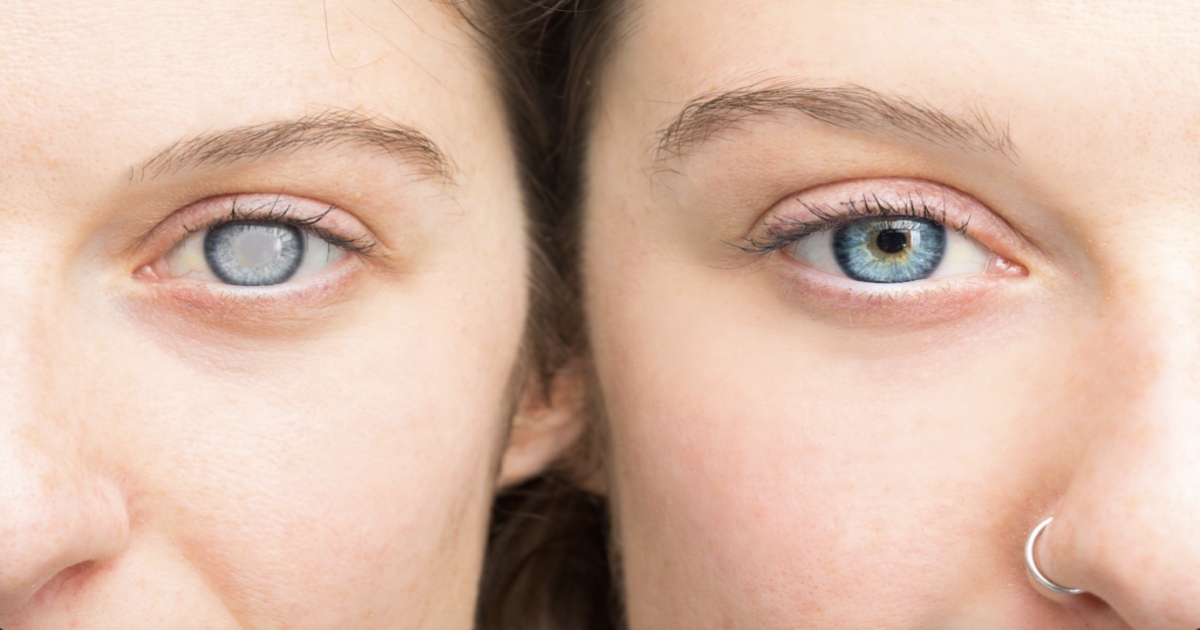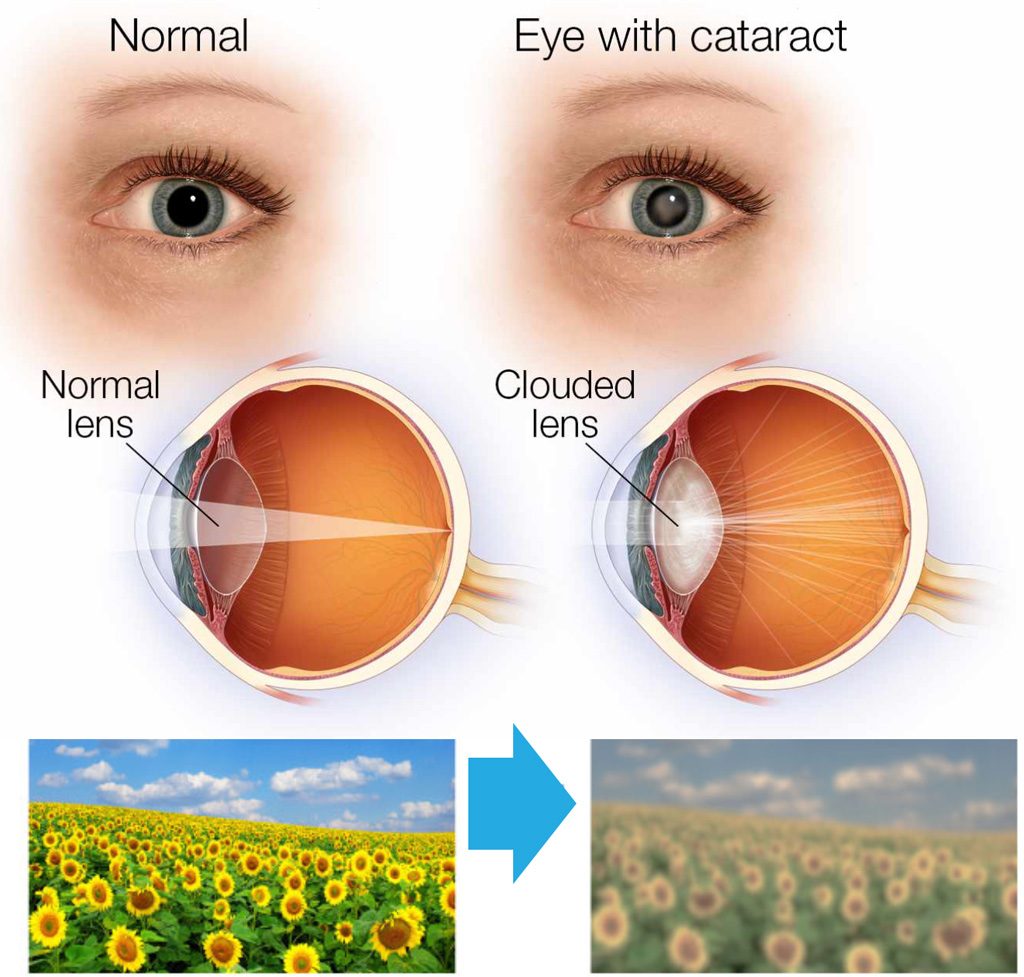

What is a cataract?
A cataract is a cloudiness of the eye’s natural lens, which lies directly behind the pupil.
What causes cataracts?
The lens is mostly made of water and protein. The protein is arranged in a precise way that keeps the lens clear and lets light pass through it. But as we age, some of the protein may clump together and start to cloud a small area of the lens. This is a cataract, and over time, it may grow larger and cloud more of the lens, making it harder to see.
No one knows for sure why the eye’s lens changes as we age, forming cataracts. Besides advancing age, cataracts can also be caused by injury, chronic diseases and prolonged use of corticosteroid medication and smoking.
Can cataracts cause blindness?
Yes – if left untreated, cataracts cause continual loss of vision, eventually leading to legal blindness or even total blindness. Visual outcomes of modern cataract surgery are so good that a person who was legally blind prior to surgery often is able to see well enough to drive without eyeglasses after surgery.
When should cataract surgery be considered?
For best results from cataract surgery, it’s generally recommended to have the surgery performed before the cataract causes low vision or legal blindness. Advanced cataracts that cause severe vision loss are more difficult to remove and increase the risk of cataract surgery complications.

Are cataracts found only in older people?
Most cataracts develop slowly over time and affect people over age 50. About half of the U.S. population has a cataract by age 65. Nearly everyone over age 75 has at least a mild cataract in one or both eyes. In rare cases, infants can have congenital cataracts. These usually are related to the mother having German measles, chickenpox, or another infectious disease during pregnancy; but sometimes they are inherited.
My doctor says I have a cataract, but he wants to wait before removing it. Why?
Mild cataracts often cause little or no vision problems. Your doctor is probably monitoring your cataract to see if it worsens and more significantly affects your vision or lifestyle before recommending surgery. Some cataracts never reach the stage where they need to be removed. But if your cataract worsens and you begin to have trouble seeing clearly for driving and other everyday tasks, it’s probably time to consider cataract surgery.
Is cataract surgery serious?
All surgery involves some risk.
However, cataract surgery carries a very low risk and is one of the most rewarding and commonly performed surgical procedures.

How is a cataract removed?
A small incision is made in the front surface of the eye with a scalpel or diamond blade. A circular hole is then cut in the front of the thin membrane (anterior capsule) that encloses the eye’s natural lens. Typically the lens is then broken into smaller pieces with an ultrasonic device. Then it can be removed easily from the eye. Once the entire lens is removed, it is replaced with a clear implant called an intraocular lens (IOL) to restore vision. In most cases, the eye heals quickly after surgery without stitches.
What is a “secondary cataract”?
In a minority of cases (perhaps 20-30%), months or years after cataract surgery, the posterior portion of the lens capsule that is left inside the eye during surgery for safety reasons becomes hazy. This causes the vision to become blurred again. This “secondary cataract” (also called posterior capsular opacification) usually can be easily treated with a less invasive follow-up procedure called a YAG laser capsulotomy. In most cases, this 15-minute procedure effectively restores clear vision.
My grandfather had cataract surgery years ago, he had to wear thick glasses afterwards. Is this still necessary?
Rarely does anyone have to wear thick, heavy spectacles after cataract surgery these days. Most modern cataract procedures replace your eye’s natural lens with an IOL that often can correct your distance vision to 20/20. In many cases, your cataract surgeon can choose an IOL that will provide functional vision without any spectacles at all except perhaps for reading glasses.
What are the possible side effects of cataract surgery?
As with any surgery, pain, infection, swelling and bleeding are possible, but very few people experience serious cataract surgery complications. In most cases, complications or side effects from the procedure can be successfully managed with medication or a follow-up procedure.
To reduce your risk for problems after cataract surgery, be sure to follow the instructions your surgeon gives you and report any unusual symptoms immediately.
Are you awake during cataract surgery?
Most cases are done under local anaesthesia so, typically you are awake during cataract surgery.
This eliminates risks associated with general anaesthesia (being “put to sleep”) and enables your surgeon to communicate with you during your procedure. If this idea of being awake during surgery concerns your, fear not – you will be given oral medication before the procedure so you are fully relaxed and feel no discomfort.
The medication typically makes it difficult for most patients to remember their experience in the surgical suite after the brief 15 to 20-minute procedure has been completed and they are in the recovery area.
Some cases need to be done under full general anaesthesia and with modern anaesthetics this is very safe too.
Within a short period of time after your procedure, you will be able to leave the surgery center, but you should not drive after surgery. You should have someone with you to drive you home.
Can cataract surgery be performed on both eyes at the same time?
If you have cataracts in both eyes, surgery typically is performed on one eye. Then a few days or a few weeks later, it’s performed on the other eye. This approach allows the first eye to recover and your vision in that eye to stabilise before surgery is performed on the fellow eye. That said, modern cataract surgery is very safe and effective, and the rate of cataract complications is very low. This has led to some surgeons to begin offering simultaneous bilateral cataract surgery (SBCS) – in other words, cataract surgery performed on both eyes on the same day.
Cataract surgeons who support the idea of SBCS point out that a significant percentage of cataract surgeries in some European countries are performed in this fashion with no increased rate of complications. Also, advantages of same-day surgery on both eyes include lower costs, fewer office visits, faster recovery of binocular vision for driving and other critical tasks, and a quicker return to normal living.

Dr Clive Novis
